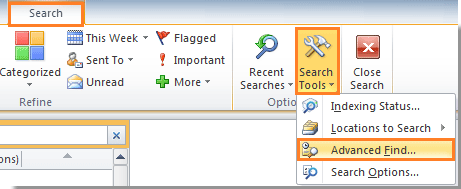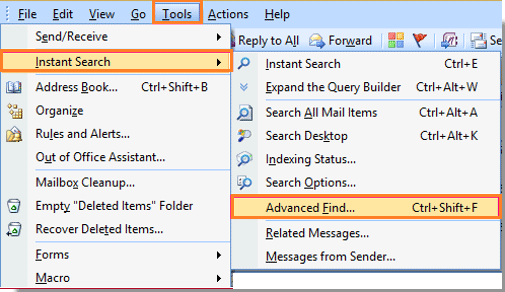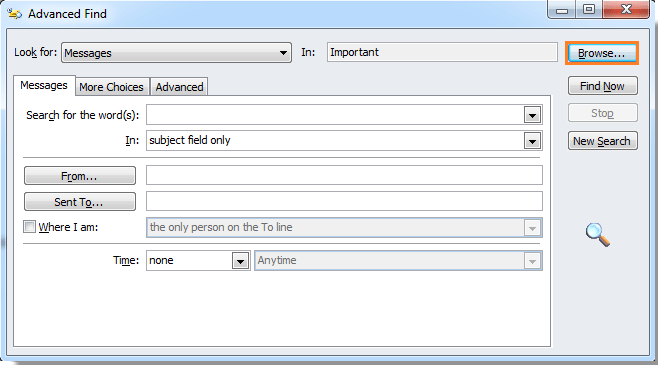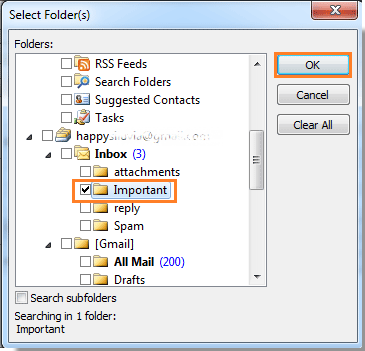Wie zeigt man den vollständigen Ordnerpfad der E-Mail-Suchergebnisse in Outlook an?
Haben Sie sich jemals darüber geärgert, dass Outlook nur den enthaltenden Ordner für jedes übereinstimmende Suchergebnis anzeigt? Wenn es in Ihrem Outlook Ordner mit gleichen Namen gibt, ist es zeitaufwendig, für ein bestimmtes Suchergebnis die spezifischen Ordner einzeln zu finden. Das Anzeigen des vollständigen Ordnerpfads der E-Mail-Suchergebnisse ist eine effiziente Möglichkeit für Sie, den entsprechenden Ordner der gesuchten E-Mails zu finden. Bitte lesen Sie den folgenden Artikel für weitere detaillierte Informationen.
Vollständigen Ordnerpfad der E-Mail-Suchergebnisse in Outlook anzeigen
Vollständigen Ordnerpfad der E-Mail-Suchergebnisse in Outlook anzeigen
Um den vollständigen Ordnerpfad einer E-Mail in der Suchergebnisliste in Outlook zu finden, gehen Sie bitte wie folgt vor.
1. Nachdem Sie die Suche nach E-Mails abgeschlossen haben, wählen Sie bitte eine E-Mail aus, deren vollständigen Ordnerpfad Sie anzeigen möchten.
2. Klicken Sie dann auf Suche > Suchoptionen > Erweitert Finden in Outlook 2010/2013/2016, oder Sie können die Tastenkombination Strg + Umschalt + F drücken, um die Funktion „Suchen und Ersetzen“ zu aktivieren.

Tipp: In Outlook 2007 klicken Sie bitte auf Extras > Sofortsuche > Erweitert Finden, um das Dialogfeld „Suchen und Ersetzen“ zu öffnen, siehe Screenshot:

3. Im erscheinenden Dialogfeld „Erweitert Finden“ klicken Sie bitte auf die Schaltfläche Durchsuchen.

4. Nach dem Klicken auf Durchsuchen in dem Erweitert Finden Dialogfeld wird ein Ordner auswählen Dialogfeld angezeigt. In diesem Dialogfeld können Sie den spezifischen Ordner Ihrer ausgewählten E-Mail sehen, der mit einem ![]() Markierung versehen ist.
Markierung versehen ist.

Mit dieser Methode können Sie den vollständigen Ordnerpfad des Suchergebnisses auf einen Blick sehen und leicht zum entsprechenden Ordner navigieren, um die gesuchte E-Mail zu finden.
Mehrere E-Mails in andere Formate exportieren (PDF/HTML/WORD/EXCEL) in Outlook |
| Manchmal möchten Sie möglicherweise E-Mails in einem Ordner als Dateien in anderen Formaten speichern oder exportieren, z. B. als PDF-, Word- oder Excel-Dateien in Outlook. In Outlook kann weder die Funktion „Speichern unter“ noch die Exportfunktion diese Aufgabe bewältigen. Allerdings kann das Hilfsprogramm „Speichern unter“ von Kutools für Outlook mehrere E-Mails gleichzeitig in einem Ordner als Dateien in verschiedenen Formaten exportieren. Klicken Sie hier für eine kostenlose 45-tägige Testversion! |
 |
| Kutools für Outlook: Mit Dutzenden praktischer Outlook-Add-ins, kostenlos und uneingeschränkt 45 Tage lang testbar. |
Beste Office-Produktivitätstools
Eilmeldung: Kutools für Outlook veröffentlicht kostenlose Version!
Erleben Sie das brandneue Kutools für Outlook mit über100 unglaublichen Funktionen! Jetzt herunterladen!
📧 E-Mail-Automatisierung: Automatische Antwort (verfügbar für POP und IMAP)/E-Mail senden planen/Automatische CC/BCC nach Regel beim Senden von E-Mail/Automatische Weiterleitung (Erweiterte Regeln) /Begrüßung automatisch hinzufügen/E-Mails mit mehreren Empfängern automatisch in einzelne E-Mails aufteilen...
📨 E-Mail-Management: E-Mail zurückrufen/Betrugs-E-Mails nach Betreff und anderen Kriterien blockieren/Duplikate löschen/Erweiterte Suche/Ordner organisieren...
📁 Anhänge Pro:Stapel speichern/Stapel ablösen/Stapel komprimieren/Automatisch speichern/Automatisch abtrennen/Automatische Komprimierung...
🌟 Interface-Magie: 😊Mehr schöne und coole Emojis /Benachrichtigung bei wichtigen E-Mails/Outlook minimieren statt schließen...
👍 Ein-Klick-Genies: Allen mit Anhängen antworten /Anti-Phishing-E-Mails/🕘Zeitzone des Absenders anzeigen...
👩🏼🤝👩🏻 Kontakte & Kalender: Stapel Kontakt aus ausgewählten E-Mails hinzufügen/Kontaktgruppe in einzelne Gruppen aufteilen/Geburtstagserinnerung entfernen...
Verwenden Sie Kutools in Ihrer bevorzugten Sprache – unterstützt Englisch, Spanisch, Deutsch, Französisch, Chinesisch und über40 weitere!


🚀 Ein-Klick-Download — alle Office-Add-Ins verfügbar
Dringend empfohlen: Kutools für Office (5-in-1)
Mit einem Klick laden Sie fünf Installationsprogramme gleichzeitig herunter — Kutools für Excel, Outlook, Word, PowerPoint und Office Tab Pro. Jetzt herunterladen!
- ✅ Ein-Klick-Komfort: Laden Sie alle fünf Installationspakete in nur einem Schritt herunter.
- 🚀 Für jede Office-Aufgabe bereit: Installieren Sie die benötigten Add-Ins genau dann, wenn Sie sie brauchen.
- 🧰 Enthalten: Kutools für Excel / Kutools für Outlook / Kutools für Word / Office Tab Pro / Kutools für PowerPoint